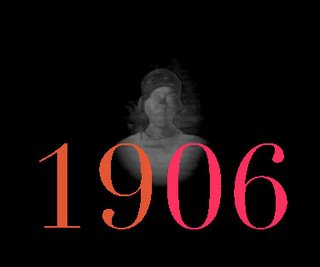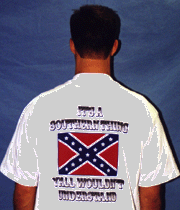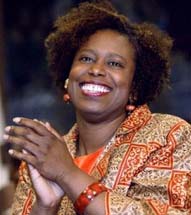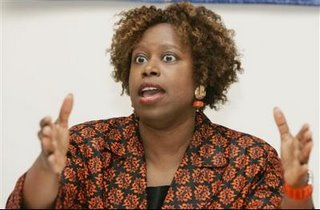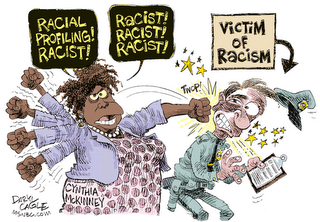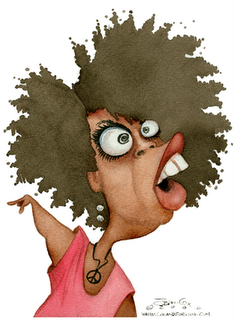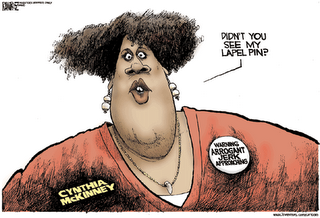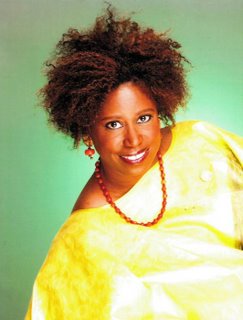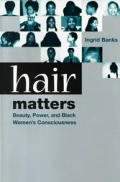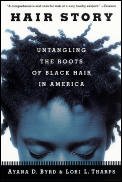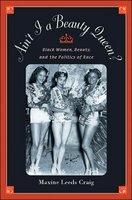
Short report this month, cause life is in flux and so is my time. There are fewer films and more viewed for work (all the teen dreck). This month I was ruined by one film and officially it wasn't even a traditional film, it was 4+ hours mini-series. Not that I noticed.
1. Angels in America (2003) Dir. Mike Nichols. Yes, ruint, thusfar I cannot watch anything else and gain any satisfaction.
Tony Kushner's meditation on the meaning of life, love, race, sex, and the question of God's existence amid the early days of the AIDS crisis in New York. Kushner's writing, his characters, and the casting made me remember why I love theater. The last theater I saw was a year ago, a musical,
The Color Purple: The Musical. I appreciate
Ms. Winfrey giving African American musical theater actors a vehicle to on and from which to work, grow, and gain recognition, but it has been a while since musical theater in the US has been innovative, and this was primarily an example of traditional musical theater. That's fine, but I wanted something more, something deeper. That something more was there in
Angels in America, and while I sincerely admired Nichol's staging and direction, as well as
Paul Hsu's innovative sound design, I feel like this work could have been set in a black box with no props and the actors still would have nailed their performances--the folks are that brilliant. I'm one of those folks who doesn't care if s/he never sees
Meryl Streep in another performance. I got burned out on her in the 1980s and the fuse was never relit for me. Now I realize she just never got material truly up to her level after she hit 40, so I found myself enjoying her again as she truly disappeared into fascinating characters with quite human dialogue, and enough spaces to for her performance to suffuse into (as opposed to dead spaces that an actor has to ballast). What stood out for me was the

work here for me comes from the trio of
Ben Shenkman,
Justin Kirk, and
Jeffrey Wright, plus
Patrick Wilson as the Mormon golden boy. Jeffrey Wright is my IBM (Ideal Black Man). I mean as an artist, since I don't know him as a human being. I just love him in everything I've seen him in, he brings such fearlessness, depth, and intelligence to his diverse collection of roles. I would love to watch the movie of life that rolls inside his brain for 30 minutes. (
Being Jeffrey Wright) But I also think Ben Shenkman is stunning as character Louis Ironson, who we expect to hate; he abandons his lover of 4 and a half years, Prior Walter (Kirk), when the latter develops AIDS. I didn't hate him, I was disgusted with and annoyed by that character but on a meaningful level, he earned it with the particularities of his flaws, they had if not a complete backstory character unto themselves. Yet but I still saw his humanity, his intelligence, his sensuality, could see why his boyfriend had loved him in the first place. Ultimately the resolution of that relationship and way that interweaves with the resolution of the relationship between closeted
Roy Cohn underling and Morman Joe Pitt, and his emotionally unstable wife, Harper (
Mary-Louise Parker who made me wish that she had reprised her stage role in the film adaptation of
Proof (not that I've seen it but I have the same feeling about
Gwyneth Paltrow as I used to have about Streep, let's hope it's because Paltrow has exhausted US film material and not that she's just played out--she's always good, but like an acting machine). When Joe shows himself to be both heartless and vulnerable, self-involved and broken he too is not completely unlikeable and both he and Louis are ultimately forgiveable but neither can be bestowed with the same kind of love they took for granted as their right, theirs to receive or put on hold until they felt like reciprocating. There are not easy characterizations here. And then
Emma Thompson as a visionary, confused, amorous, and somewhat violent angel, what can you say. Kushner earns each step his characters make in their development, they don't just move forward to serve a plot point, or because the genre requires it. I also realized how rare it was for me to happily anticipate the next bit of dialogue because I had no clue of what was coming next, of which way a character was going. The actors were so good at listening to each other's performances--I always felt they were in the moment, but also with Kushner's writing again there weren't easy progressions, there wasn't a formula I could see coming a mile away. It ruint me, I tell ya, just ruint me in the best possible way.
 2. The Joy of Life (2005) Dir. Jenni Olson
2. The Joy of Life (2005) Dir. Jenni Olson. I had been reluctant to see this film, ostensibly an experimental film wrapped inside a 65 minute documentary, only because in part it deals with the death of her friend and colleague
Mark Finch, the late director of the
San Francisco International Lesbian and Gay Film Festival (SFILGFF). Olson was Assistant Director of the SFILGFF having come to San Francisco after having founded successful film screening series in Minneapolis, Minnesota as an undergraduate student. Mark Finch committed suicide by jumping from the Golden Gate Bridge in early 1995. I have just told you just about all that Olson covers of his death in the film, maybe a little more as I named the year. I did not know Finch well, he had asked me one year if I wanted to play host to British film historian
Richard Dyer for a talk he was giving during the festival and I stupidly declined. I can no longer remember my specific reasoning for saying no only that it was silly. I served on a screening committee with him, and we knew each other to say hello. But still when he killed himself, I felt deeply affected. I imagine a number of people felt this way. It was 1995, a year of considerable loss due to AIDS, felt in different communities but particularly in the San Francisco Bay Area and in various arts communities. So here was this loss at so many levels, people lost a friend a colleague, the city lost someone who had nurtured the festival into its latest incarnation as a truly international festival, with his connections in Europe, and a long history of involvement in film programming in Britain. So the world, primarily the west, lost this person of great vision and great film love. And it was unsettling because it wasn't easy to know exactly why, why we had lost him. The first part of
The Joy of Life is primarily about Olson's search for personal happiness as a butch lesbian, the often fragile nature of joy when she does find it, and yet her continued resiliency in that quest. The second part, marked by a black screen and
Lawrence Ferlinghetti reading one of his own poems about San Francisco, begins the tale of suicide in
Frank Capra films, the influence of
Johann Wolgang von Goethe's
Die Leiden des jungen Werthers/The Sorrows of Young Werther, and the sad legacy of the
Golden Gate Bridge which at 1300 recorded suicides is the
nation's world's number one suicide landmark. Olson enumerates the original plan for the Bridge which included a barrier of 5'6'' which was then lowered to 4' making it considerably easier for the desconsolate to maneuver and the over 50 years worth of debates and review of the barrier issue. Official records of suicides ended at the 999th death. I guess someone decided that if they just stopped mentioning it people would stop doing it. Now the determination is made based on the review of bodies pulled from the Bay. The main consequence seems to be that the numbers are harder to obtain, but people are still jumping and the irregular currents and riptides mean that a number of bodies are not recovered; some estimate the numbers at twice the recorded 1300.
Harriet "Harry" Dodge provides a measured voice over, simultaneously emotive and restrained. Oddly either Dodge has

consciously imitated Olson's voice or the two have some similar vocal qualities; I had to keep reminding myself that it was Dodge, by the end I gave up and just let my mind go with the idea I was hearing Olson (pictured right at Sundance) intoning her thoughts over still long takes of empty post-sunrise San Francisco thoroughfares, side streets, alleys, and city, bay, industrial and bridge vistas, a style that emerged for Olson with her second and third short diary films "Meep, Meep!" and "Blue Diary." A meditative thoughtful work worth seeing. A note: As I was completing this post I read poet
Marvin K. White's post about his friend
Rickey who recently also lept to his death from the Golden Gate Bridge. White explores the thoughts and emotions triggered by this loss in an entry titled,
"The dead can offer no answer. We must question the living." This is one of the most frank and searching pieces I've read on black folks and mental health, and worth reading.
 3. She's All That (1999) Dir. Robert Iscove
3. She's All That (1999) Dir. Robert Iscove. I wish either she or the movie had been
all that as watching this movie would have been made easier one or the other were true. The racial dynamics alone in this movie were enough to make my head spin. The use and abuse of African American masculinity with
Dulé Hill and the deployment of the African American and Latina hand maiden,
Gabrielle Union,
Tamara Mello, and '
Lil' Kim. The latter portrayals began to resemble
Manet's Olympia the MTV version, although I believe it was the black male emasculation (within a capitalist framework of masculine identity of sexual conquest and consumerism) that was parodied in
Not Another Teen Movie. I'm glad to see
Freddie Prinze Jr. liberated to TV because in film he tends to act with his admittedly knee-weakening teddy bear brown eyes, with their frame of dense eyelashes and furrowed brows, but not much else. On TV his mama's boy character seems to have been forced into adulthood and Latinadad identity. I appreciate the
Hector Elizando "Best Latino Actor In a Cross-Over Role" legacy as much as anyone, but Elizando has actually played Latino characters, Prinze was in danger of never having that opportunity. As for
Rachel Leigh Cook, I haven't been stirred by any of her work since her passionately destructive wielding of a frying pan in the "this is your brain on drugs" anti-drug PSAs of the 1990s.
 4. She's the Man (2006) Dir. Andy Fickman
4. She's the Man (2006) Dir. Andy Fickman. In which I found out that while
Amanda Bynes' skill for physical comedy is precocious given her age, the lack of pathos in her portrayals, and her ubiquitous on-screen pleasantness (think
Doris Day without
Burt Reynolds) keeps her from being a truly great comedic talent--like not even at Kevin James (Hitch, King of Queens) level let alone that of
Jeremy Piven, which is where I think she aspires to be, notwithstanding her stated
Jennifer Anniston aspirations (Anniston was good in
Miguel Arteta and
Chuck White's
The Good Girl, but then, well who knows what happened, "movie star" handling?). Bynes stars as Viola, a stand-out on her high school's girl's soccer team, until the team gets cut and the coach won't let the girls try out for the boys team (ruining her chances to be seen by the UNC recruiter--she wants to be "a Blue Devil" even though she won't get as much playing time there as at another school: hunh?), and her boyfriend--team captain and goalie sides with the coach. Meanwhile her twin brother Sebastian is hightailing it to London for two weeks to pursue his music dreams. Just enough time for her to become a boy and pretend to be him at his new school, try out and make the starting line up on that school's boys soccer team (apparently they don't have a girl's team either) and give her ex the public beat down he deserves on the soccer field. Of course, the best

laid plans are subject to some necessary revision and along the way both brother and sister find love, a sensitive guy who can still throw a punch learns a girl can be a friend
and a lover, and everyone gets paired off at the end. These days if teens are going to interrogate gender I want to see some more uneasiness than found in the primarily easy payoffs evident here. I know it's based on
Twelfth Night, but don'tcha think if William S. was around now he'd push the envelope a bit more? This stays well within everyone's comfort zones which is too bad (Fickman also directed
Reefer Madness: The Musical)Given that adolescence is the time when gender is most in flux and discomforting they could have done so much more with these characters and situations. Oh and the portrayals of black folks, back in time, so sad. With Amanda Bynes inconsistently doing some sort of psuedo black male/urban speak which then lapses into would-be white southern boy dirty south drawl, and then into her own voice and back again without it being a particular failing of the character but instead an apparent attempt to masculinize a character that looks like a twelve year old boy. Everything but the burden indeed.
 4. 10 Things I Hate About You (1999) Dir. Dir. Gil Junger
4. 10 Things I Hate About You (1999) Dir. Dir. Gil Junger. Well here's a well-done Shakespeare adaptation with a solid soundtrack. But then it's got a solid cast not just stuffed with pretty people. Julia Stiles, a pre-
Brokeback Heath Ledger whose mouth still looks like an unresolve wound part of the time, i.e. you can see the Brokeback performance seedlings.
David Krumholtz who I've already cited as a great talent, as the nebbishy aspiring MBA with a romantic soul. Pre-
Mysterious Skin Joseph Gordon-Levitt as an atypical hottie, and
Julia Stiles as the shrew in this adaptation of her taming. Comedian
Larry Miller as her father, a quirky and paranoid ob-gyn whose patient demographics has him terrified of teenage pregnancy,leading him to proclaim that his younger daughter cannot date until his older "did you make anyone cry today, honey?" daughter does. Deep Bad boy Ledger is conscripted into the taming, while superficial pretty boy/bad boy
Andrew Keegan attempts to reap the

rewards by de-virginizing the younger sister, as Gordon-Levitt attempts to romance the self-involved younger sister. Ultimately this screenplay doesn't garner the charges of misongyny that Taming has earned, but some of that anxiety is indirectly displaced onto unresolved issues of gendered race, and class, most obviously embodied in the characters played by
Gabrielle Union (as, what else, the best friend) and
Daryl "Chill" Mitchell (as a frustrated English teacher) respectively.
 5. Notorious C.H.O (2002) and 6. Cho Revolution (2004) Dir. Lorene Machado
5. Notorious C.H.O (2002) and 6. Cho Revolution (2004) Dir. Lorene Machado (both). Notorious Cho I realized I had seen before, but I get to see the interviews with her parents which is the best part of the DVD, they just love her and are proud of her. It's quite something to see. I like Cho despite the unease with which I sometimes experience her maternal mimicry. With her most recent incarnation in
Cho Revolution she's lost weight and

developed a black drag queen-WeHo (West Hollywood) diva intonation that she regularly lapses into especially for the punchline of her less politically saavy work. It truly got on my nerves, especially since it was a cheat, she didn't have to really work for the laugh with the degree people have been conditioned to laugh at the sound of those particular vocal intonations and phrasings. I appreciate the personality and character of her actually voice and voice sounds like a caricature of the "sassy black women" from which those drag queens and divas are gathering their style and strength.
I wondered if Cho had just been inculcated by her time in West Hollywood, like is "pseudo urban black" the new lingua franca there? Cho is also doing a rap comedy show (Yikes!) in which she appears as "MCMC" along with her fellow comic African American
Bruce Daniels. The loss of weight has changed Cho's physical presence--the definition of her face, her main instrument, is different and you can see her working to make adjustments. The body of a female comic is under a particular kind of scrutiny, subject to a particular kind of read--it often becomes part of her comedy intentionally or not, in a manner not experienced by male comics. In the history of female comics in the US a funny big girl, or funny-looking funny girl is a comedic normalcy. For Cho, some of her staples, particularly talking graphically about sex and dieting, read dissimilarly coming from a "big girl" (more of an "every-girl", or at times a "subversive girl"), than from a more svelte, bare-armed, markedly femme-fashioned body. Physically she's employing her body with some new methods which has opened up her comedy, apparent in a quite funny bit she did about airline steward nervously serving her "Asian Chicken Salad". At the same time her face is smaller which means that her main canvas--as one fan said "no one can pull a face like Margaret Cho"--doesn't offer her quite the same opportunities for expressiveness, so it is interesting to watch her work her body differenttly.
 7. The 24th Day (2004) Dir. Tony Piccirillo
7. The 24th Day (2004) Dir. Tony Piccirillo. Piccirillo's writing here is a bit uneven, at points this come across as a morality play instead of a human drama, and unfortunately a good theater staging does not always make for a good film. The story of a married man who was recently diagnosed with HIV, Tom (
Scott Speedman), who had a single sexual encounter with another man, Dan (
James Marsden) who he stalks and kidnaps in order to obtain a blood sample for testing with the intention of letting him go if the results are negative and killing him if they aren't. In this case the plot, which already feels dated, suffers from Piccirillo's inconsistent direction. Nevertheless Speedman comes across as a capable actor despite the fiasco of replacing
Brad Pitt in the ill-fated
Gwyneth Paltrow vehicle
Duets (2000). But this isn't the film that changed things for him or James Marsden who has perhaps gotten more beyond pretty-boy credibility, with his role in
Heights (2004). The problem is the pacing, which probably worked with a claustrophobic stage design but doesn't work here. In addition, the premise of Speedman's motivation, that only a gay man could have given him HIV instead of the possibility of it being his wife, insists on reinforcing the idea of this as a "gay disease." In spite of this, I thought both Marsden and Speedman were quite capable in their roles, with Speedman making the most of his character's particular arc.
8. Hatuna meuheret/Mariage tardif/Late Marriage (2001) Dir. Dover Kosashvili.
After seing Israeli actor Lior Ashkenazi in Walk on Water(2004), where he played an Israeli agent on the trail of an aging Nazi war criminal. I was curious about his other work. He's good at playing men who come from a rigid and closed frame of reference, with which they eventually find themselves at odds. In this case he plays Zaza, a 31 year old philosophy graduate student whose Georgian parents are setting him up with numerous women in an effort to arrange a marriage. After he rejects numerous brides in desperation the family organizes a stake-out and discovers the son having a relationship with Judith (the striking Ronit Elkabetz), a divorcee who has a precocious daughter. Zaza is apparently quite happy and has created a surrogate family where he's almost fully himself. The film also features some of the more sensual heterosexual love scenes I've witnessed in film as of late. Unfortunately, all hell breaks loose as the family stages an intervention where painful family secrets are hinted at, their eventual exposure shows the power of familial love, the weight of patriarchal control on those who wield it and those against it is enacted, and the impact of generations of unquestioning adherence to those traditions. Ashkenazi is quite good as a man whose sheltered existence hasn't prepared him for the consequences of following his heart's desires.
graduate student whose Georgian parents are setting him up with numerous women in an effort to arrange a marriage. After he rejects numerous brides in desperation the family organizes a stake-out and discovers the son having a relationship with Judith (the striking Ronit Elkabetz), a divorcee who has a precocious daughter. Zaza is apparently quite happy and has created a surrogate family where he's almost fully himself. The film also features some of the more sensual heterosexual love scenes I've witnessed in film as of late. Unfortunately, all hell breaks loose as the family stages an intervention where painful family secrets are hinted at, their eventual exposure shows the power of familial love, the weight of patriarchal control on those who wield it and those against it is enacted, and the impact of generations of unquestioning adherence to those traditions. Ashkenazi is quite good as a man whose sheltered existence hasn't prepared him for the consequences of following his heart's desires.
9. Spy Kids 2: Island of Lost Dreams (2002) Dir. Robert Rodriguez. His second trip 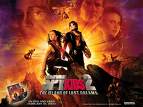 into the land of children’s make-believe with the return of lessons in family values, ego and anger management, and personal integrity all dressed up in a fun sometimes sarcastic and snarky kids film. Rodriguez gets point in my book for a narrative that explores the reality of children having to develop a sense of integrity and personal ethos independent of their parents’ (especially when mom and dad’s priorities are questionable). Alan Cummings and Tony Shalhoub briefly reprise their roles and I for one missed them once they were gone, the new villain, a rival in father Antonio Banderas’ attempt to head the OSS spy organization, is played with bland
into the land of children’s make-believe with the return of lessons in family values, ego and anger management, and personal integrity all dressed up in a fun sometimes sarcastic and snarky kids film. Rodriguez gets point in my book for a narrative that explores the reality of children having to develop a sense of integrity and personal ethos independent of their parents’ (especially when mom and dad’s priorities are questionable). Alan Cummings and Tony Shalhoub briefly reprise their roles and I for one missed them once they were gone, the new villain, a rival in father Antonio Banderas’ attempt to head the OSS spy organization, is played with bland arrogance by Mike Judge (who sadly has a rather forgettable face, except for it being so remarkably anglo in comparison to most of the other adult leads). The kids, Alex Vega (who gets to sing on the soundtrack) and Daryl Sabara, have grown and developed into full-fledged spies with their sibling warfare intact, each of the kids has a love interest, and they do a fairly good job of carrying most of the film. Vega evidences a more spirited personality and has more fight scenes than the younger Sabara, the sensitive little brother, good at counseling would be villains to consider a new world view. Great guest spots
arrogance by Mike Judge (who sadly has a rather forgettable face, except for it being so remarkably anglo in comparison to most of the other adult leads). The kids, Alex Vega (who gets to sing on the soundtrack) and Daryl Sabara, have grown and developed into full-fledged spies with their sibling warfare intact, each of the kids has a love interest, and they do a fairly good job of carrying most of the film. Vega evidences a more spirited personality and has more fight scenes than the younger Sabara, the sensitive little brother, good at counseling would be villains to consider a new world view. Great guest spots  here by Rodriguez-Tarantino alum Steve Buscemi as an inadvertently mad zoologist, who has created a mutant Noah’s Arc and fellow Texan Bill Paxton as a sort of modern entrepreneurial Will Rogers of amusement parks. Rodriguez’s notion of family values is that daddy is the leader and everyone else falls in behind him, although daddy is the subject of some disparaging humor.
here by Rodriguez-Tarantino alum Steve Buscemi as an inadvertently mad zoologist, who has created a mutant Noah’s Arc and fellow Texan Bill Paxton as a sort of modern entrepreneurial Will Rogers of amusement parks. Rodriguez’s notion of family values is that daddy is the leader and everyone else falls in behind him, although daddy is the subject of some disparaging humor.
10. (Repeat) High Fidelity (2000) Dir. Stephen Frears. I get now that Frears is an art  film director for hire, he’s not an auteur, which means that his director’s commentary is rather dry. But I watched this again to hear Stevie Wonder’s “I Believe,” which in this music saturated film is the last and irrefutably the most important song of the soundtrack given the protagonist’s character arc. In the meantime I was reminded of what a gem this is, stunning early work by Jack Black, a brief sexy moment from Lisa Bonet, who can sing. All this and a charmingly wrecked John Cusack as a jaded 30ish consummate ass boy-man until he finally commits to actually showing up for his life.
film director for hire, he’s not an auteur, which means that his director’s commentary is rather dry. But I watched this again to hear Stevie Wonder’s “I Believe,” which in this music saturated film is the last and irrefutably the most important song of the soundtrack given the protagonist’s character arc. In the meantime I was reminded of what a gem this is, stunning early work by Jack Black, a brief sexy moment from Lisa Bonet, who can sing. All this and a charmingly wrecked John Cusack as a jaded 30ish consummate ass boy-man until he finally commits to actually showing up for his life.
11. Gangstresses (1999) Dir. Harry Davis. This is a disorganized documentary shot over a  three year period which deals with black women hustlers: those working in pornography, as prostitutes, and drug dealers. With the tagline "There's one [a gangstress] in every woman," the documentary features interviews with hip hop stars Mary J. Blige, and Lil’ Kim and a number of underground female rappers, and features porn star/dancer Champagne, who attempts to break through the sexist boys club of men’s club adult entertainment management. There are also Pamela, a prostitute, and her daughter Tamieka, some women who identify as hustlers in a vague manner (presumably not to implicate themselves in any current illegal activities) and a number of sex workers, all of whom have the intent of building up their nestegg in order to take care of their families. The approach here is to glamorize and mythologize this life with interviews from Lil Kim, Mary J. Blige, Russell and Kimora Simmons about gangstresses, but then pull back the high gloss sheen and show the reality of women being subjected to violence and sometimes murdered when living by the hustle or participating in the hustle of a male romantic partner. The film gives little context for the lives of these women, nor does it situate them in a larger framework of African American women’s lives—e.g. those poor working women who choose not to hustle. From this documentary you would think all poor black women do was work in illegal industries, as though it were default mode. Finally, the last part of the film delves substantially into the adult entertainment industry with a considerable amount of graphic footage of black women engaged in various forms of sex work,to the extent that it re-exploits these women. I think this work is now out of print.
three year period which deals with black women hustlers: those working in pornography, as prostitutes, and drug dealers. With the tagline "There's one [a gangstress] in every woman," the documentary features interviews with hip hop stars Mary J. Blige, and Lil’ Kim and a number of underground female rappers, and features porn star/dancer Champagne, who attempts to break through the sexist boys club of men’s club adult entertainment management. There are also Pamela, a prostitute, and her daughter Tamieka, some women who identify as hustlers in a vague manner (presumably not to implicate themselves in any current illegal activities) and a number of sex workers, all of whom have the intent of building up their nestegg in order to take care of their families. The approach here is to glamorize and mythologize this life with interviews from Lil Kim, Mary J. Blige, Russell and Kimora Simmons about gangstresses, but then pull back the high gloss sheen and show the reality of women being subjected to violence and sometimes murdered when living by the hustle or participating in the hustle of a male romantic partner. The film gives little context for the lives of these women, nor does it situate them in a larger framework of African American women’s lives—e.g. those poor working women who choose not to hustle. From this documentary you would think all poor black women do was work in illegal industries, as though it were default mode. Finally, the last part of the film delves substantially into the adult entertainment industry with a considerable amount of graphic footage of black women engaged in various forms of sex work,to the extent that it re-exploits these women. I think this work is now out of print.
 12. Dancing in September (2001) Dir. Reggie Rock Bythewood
12. Dancing in September (2001) Dir. Reggie Rock Bythewood
An HBO movie also written by Rock Bythewood about how a well-intentioned talented African American television writer (Nicole Ari Parker) and producer (Isaiah Washington) lose their way producing what becomes a number one show on a white-run start up network thereby securing the success of the network. Basically it comes up as a dramatization of the behind the scenes history of Norman Lear's "Good Times" and Kristal Brent Zook's take on how the Fox Network established itself with the success of African American shows which it then dumped and replaced with white shows to further secure the white demographic. A less surreal take on network television and race than Spike Lee's Bamboozled, it's considerably less operatic tone also is more successful in suggesting an insidious pattern of appropriation, cooptation, and abdication of black comedic narrative (since no black character centered hour long drama has ever been successful on network television--witness the early demise of the excellent "Gideon's Crossing"). It is also memorably one of the few times you'll see mental illness dealt with by name in a black film, even though the end it's given an over the top representation.
 13. Clean (2004) Dir. Olivier Assayas. Why did it take so long for this to gain a US release, after Maggie Cheung won the Best Actress award, and Eric Gautier won for Cinematography at Cannes (he also won in for Motorcycle Diaries [2004]) and Assayas was nominated for a Golden Palm for direction but lost (Michael Moore's Fahrenheit 9/11 was the awardee). I've heard that this film doesn't cohere, that it's mainly something that fans of Assayas and Cheung (Irma Vep groupies?) will enjoy, but no one else. I haven't seen anything else by Assayas, although I keep meaning to see Irma Vep (1996). This film reminded me of Lisa Cholodenko's High Art (1998) and Gilliam Armstrong's High Tide (1987), not so much because of the subject matter: abandoned children, drifting
13. Clean (2004) Dir. Olivier Assayas. Why did it take so long for this to gain a US release, after Maggie Cheung won the Best Actress award, and Eric Gautier won for Cinematography at Cannes (he also won in for Motorcycle Diaries [2004]) and Assayas was nominated for a Golden Palm for direction but lost (Michael Moore's Fahrenheit 9/11 was the awardee). I've heard that this film doesn't cohere, that it's mainly something that fans of Assayas and Cheung (Irma Vep groupies?) will enjoy, but no one else. I haven't seen anything else by Assayas, although I keep meaning to see Irma Vep (1996). This film reminded me of Lisa Cholodenko's High Art (1998) and Gilliam Armstrong's High Tide (1987), not so much because of the subject matter: abandoned children, drifting dissolute lives, strung out junkie artists, and in the world of dive music joints. Armstrong's film is probably among my favorite films of all time. Similar to Judy Davis' character Maggie Cheung's Emily is no one's friend, she's self-involved has abandoned the child she had with her broken down former rock star husband Lee. Maggie Cheung plays Emily as a woman slowly coming back to life, moving from heroin to methadone to just nicotine, determined to see her son again after Lee OD's and she spends six months in jail for possession. Some will see parallels between Emily's character and that of Courtney Love, but I just saw it as ex-husband Assayas wanting to create a vehicle for Cheung where she could play a role not so extraordinarily outside of herself. This would normally be unusual for an actor to be drawn to such a role or for a director to create it out of respect for the artist's talent. But in Cheung's case where she's been an action star and played "a green snake," a multilingual, multi-nation residing, woman in the contemporary era is Cheung's reality and
dissolute lives, strung out junkie artists, and in the world of dive music joints. Armstrong's film is probably among my favorite films of all time. Similar to Judy Davis' character Maggie Cheung's Emily is no one's friend, she's self-involved has abandoned the child she had with her broken down former rock star husband Lee. Maggie Cheung plays Emily as a woman slowly coming back to life, moving from heroin to methadone to just nicotine, determined to see her son again after Lee OD's and she spends six months in jail for possession. Some will see parallels between Emily's character and that of Courtney Love, but I just saw it as ex-husband Assayas wanting to create a vehicle for Cheung where she could play a role not so extraordinarily outside of herself. This would normally be unusual for an actor to be drawn to such a role or for a director to create it out of respect for the artist's talent. But in Cheung's case where she's been an action star and played "a green snake," a multilingual, multi-nation residing, woman in the contemporary era is Cheung's reality and  giving her the opportunity to play with a character with those reference points was unique. She also sings in the film; her voice is a cross between latter day Marianne Faithful and the Cowboy Junkies' Margo Timmins, a stripped nakedness I that enjoyed but it may not be for everyone. Cheung is wide open here, uneasy in her sober skin, resilient, and raw. The film also features a thoughtful, contained performance by Nick Nolte as Emily's pragmatic father-in-law who is leaning towards forgiveness.
giving her the opportunity to play with a character with those reference points was unique. She also sings in the film; her voice is a cross between latter day Marianne Faithful and the Cowboy Junkies' Margo Timmins, a stripped nakedness I that enjoyed but it may not be for everyone. Cheung is wide open here, uneasy in her sober skin, resilient, and raw. The film also features a thoughtful, contained performance by Nick Nolte as Emily's pragmatic father-in-law who is leaning towards forgiveness.
14. Mission to Mars (2000) Dir. Brian De Palma. The cinematography by Stephen H.  Burum has everyone here looking amazing. Gary Sinise (Jim McConnell) has the most brilliantly fascinating canvas of a face here, so much intelligence and complexity comes through: he should get Burum to light him for everything. Although the film features a great cast and skilled, in some cases heartbreaking performances, particularly Tim Robbins, it slows and loses its footing about halfway in. It doesn't help that thematically it bears more than a passing resemblance to John Cameron's The Abyss (1989). Unfortunately, where the
Burum has everyone here looking amazing. Gary Sinise (Jim McConnell) has the most brilliantly fascinating canvas of a face here, so much intelligence and complexity comes through: he should get Burum to light him for everything. Although the film features a great cast and skilled, in some cases heartbreaking performances, particularly Tim Robbins, it slows and loses its footing about halfway in. It doesn't help that thematically it bears more than a passing resemblance to John Cameron's The Abyss (1989). Unfortunately, where the two films part is in Mission's lack of a strong female lead. That part goes to Kim Delaney (Maggie McConnell) who plays Sinise's passionte and visionary deceased wife in a past captured on video. McConnell dropped out of the Mars program when she became ill, they were both astronauts, and so while this mission should be his to lead he doesn't even get a spot on the crew. Instead Luke Graham (Don Cheadle) leads the mission where they encounter something unexpected, and a
two films part is in Mission's lack of a strong female lead. That part goes to Kim Delaney (Maggie McConnell) who plays Sinise's passionte and visionary deceased wife in a past captured on video. McConnell dropped out of the Mars program when she became ill, they were both astronauts, and so while this mission should be his to lead he doesn't even get a spot on the crew. Instead Luke Graham (Don Cheadle) leads the mission where they encounter something unexpected, and a  rescue ensues (I could ask "why the black man gotta be rescued?" but the plot doesn't insist on Cheadle's incompetency. His Luke Graham is amazingly competent given the circumstances in which he finds himself). Everything is not as it seems on Mars, and apparently the human race has a lot to look forward to if we can keep from blowing each other up before our next stage of consciousness development.
rescue ensues (I could ask "why the black man gotta be rescued?" but the plot doesn't insist on Cheadle's incompetency. His Luke Graham is amazingly competent given the circumstances in which he finds himself). Everything is not as it seems on Mars, and apparently the human race has a lot to look forward to if we can keep from blowing each other up before our next stage of consciousness development.
15. The Human Stain (2005) Dir. Robert Benton. I screened this because of "Passing and  Failing: Reflections on the Limitations of Showing the Passer in The Human Stain," an article in a Women & Performance special issue on Passing in which Rachel Gelder argues that white critics, she doesn't name them as white, but all the ones cited in the article are, don't validate a passing narrative unless it is the story of a failed attempt. The lack of failure creates an intense sense of unease among the critics who found unbelievable the respective performances of Anthony Hopkins as Coleman Silk, a black man passing for a white Jewish professor of Classics at a presitigious New England college, and Nicole Kidman as a fallen blue blood (in Kidman's case because she seemed too beautiful to be living a blue collar life, clearly some people don't get how that rarified breeding can "out" even in a hard-lived life. And don't these people watch America's Next Top Model with its collection of beauties from a range of class strata?). Interestingl, the success of the
Failing: Reflections on the Limitations of Showing the Passer in The Human Stain," an article in a Women & Performance special issue on Passing in which Rachel Gelder argues that white critics, she doesn't name them as white, but all the ones cited in the article are, don't validate a passing narrative unless it is the story of a failed attempt. The lack of failure creates an intense sense of unease among the critics who found unbelievable the respective performances of Anthony Hopkins as Coleman Silk, a black man passing for a white Jewish professor of Classics at a presitigious New England college, and Nicole Kidman as a fallen blue blood (in Kidman's case because she seemed too beautiful to be living a blue collar life, clearly some people don't get how that rarified breeding can "out" even in a hard-lived life. And don't these people watch America's Next Top Model with its collection of beauties from a range of class strata?). Interestingl, the success of the passing narrative actually rests on the performances of Wentworth Miller and Anna Deavere Smith. Miller portrays the young Coleman Silk who decides as a
passing narrative actually rests on the performances of Wentworth Miller and Anna Deavere Smith. Miller portrays the young Coleman Silk who decides as a  teenager to pass for white, specifically Jewish, as it "benefits" him, starting with a boxing match (as Coleman "Silky" Silk), and finally to pass completely into the white world. Smith is his aggrieved mother who has some moving scenes with Miller as the son attempts to gain her understanding of the reasons for his decision without ever giving the act a name. Miller watched Hopkins' mannerisms and speaking
teenager to pass for white, specifically Jewish, as it "benefits" him, starting with a boxing match (as Coleman "Silky" Silk), and finally to pass completely into the white world. Smith is his aggrieved mother who has some moving scenes with Miller as the son attempts to gain her understanding of the reasons for his decision without ever giving the act a name. Miller watched Hopkins' mannerisms and speaking
 patterns and recreated them in the corpus of a younger, more overtly sensual man. He eerily captures Hopkins' powerfully seductive manner. By the time we return to the older Coleman he's a man entrenched in the life his ethnically marked privilege has afforded him. And even at this point we never hear him reference the act of passing. His story is told through a blocked writer friend played by Gary Sinise. Actor Wentworth Miller is of self-identified mixed heritage, and of Jamaican background the latter which adds another layer of complexity to race/culture identity and questions of the marked body given the history of blood and physical
patterns and recreated them in the corpus of a younger, more overtly sensual man. He eerily captures Hopkins' powerfully seductive manner. By the time we return to the older Coleman he's a man entrenched in the life his ethnically marked privilege has afforded him. And even at this point we never hear him reference the act of passing. His story is told through a blocked writer friend played by Gary Sinise. Actor Wentworth Miller is of self-identified mixed heritage, and of Jamaican background the latter which adds another layer of complexity to race/culture identity and questions of the marked body given the history of blood and physical appearance in Jamaica. But what if I didn't know that, or what if he were "white" how would that impact my read of his performance? Further, how would that "white" identity impact his performance, or not? I found Gelder's assertions fascinating and I know they influenced how I experienced the film and the various performances, especially Hopkins', particularly as the
appearance in Jamaica. But what if I didn't know that, or what if he were "white" how would that impact my read of his performance? Further, how would that "white" identity impact his performance, or not? I found Gelder's assertions fascinating and I know they influenced how I experienced the film and the various performances, especially Hopkins', particularly as the  actor claims not to have done any research. To Hopkins it was "just a job." Admittedly, he may have dismissed queries this way to avoid having to talk about his process which a number of actors prefer not to disclose. But what was also intriguing about Gelder's article was the detailing of how each of the main actors in this film, and director Benton (pictured left with Miller at a BAFTA/LA event) had a different definition of "passing" and what it meant to their respective characters.
actor claims not to have done any research. To Hopkins it was "just a job." Admittedly, he may have dismissed queries this way to avoid having to talk about his process which a number of actors prefer not to disclose. But what was also intriguing about Gelder's article was the detailing of how each of the main actors in this film, and director Benton (pictured left with Miller at a BAFTA/LA event) had a different definition of "passing" and what it meant to their respective characters.
